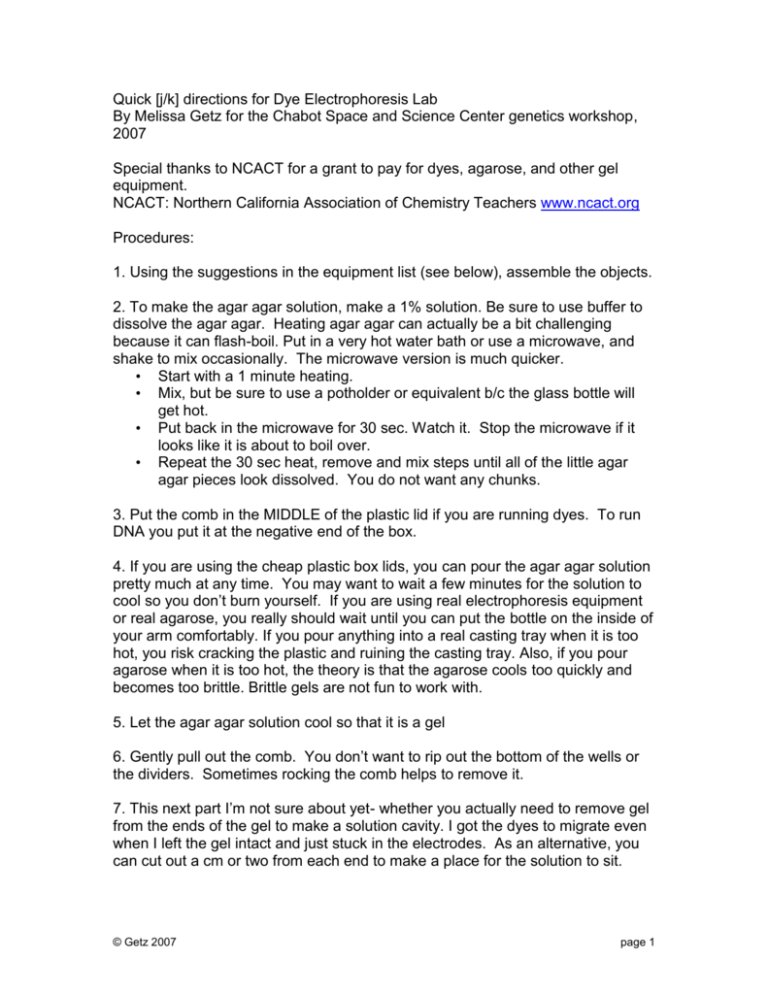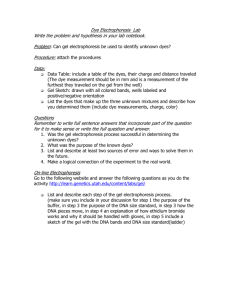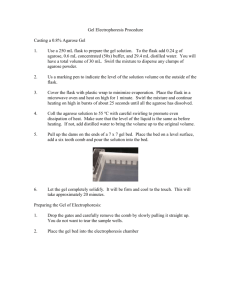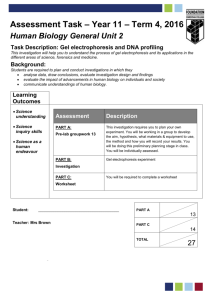Quick directions for Dye Electrophoresis Lab
advertisement

Quick [j/k] directions for Dye Electrophoresis Lab By Melissa Getz for the Chabot Space and Science Center genetics workshop, 2007 Special thanks to NCACT for a grant to pay for dyes, agarose, and other gel equipment. NCACT: Northern California Association of Chemistry Teachers www.ncact.org Procedures: 1. Using the suggestions in the equipment list (see below), assemble the objects. 2. To make the agar agar solution, make a 1% solution. Be sure to use buffer to dissolve the agar agar. Heating agar agar can actually be a bit challenging because it can flash-boil. Put in a very hot water bath or use a microwave, and shake to mix occasionally. The microwave version is much quicker. • Start with a 1 minute heating. • Mix, but be sure to use a potholder or equivalent b/c the glass bottle will get hot. • Put back in the microwave for 30 sec. Watch it. Stop the microwave if it looks like it is about to boil over. • Repeat the 30 sec heat, remove and mix steps until all of the little agar agar pieces look dissolved. You do not want any chunks. 3. Put the comb in the MIDDLE of the plastic lid if you are running dyes. To run DNA you put it at the negative end of the box. 4. If you are using the cheap plastic box lids, you can pour the agar agar solution pretty much at any time. You may want to wait a few minutes for the solution to cool so you don’t burn yourself. If you are using real electrophoresis equipment or real agarose, you really should wait until you can put the bottle on the inside of your arm comfortably. If you pour anything into a real casting tray when it is too hot, you risk cracking the plastic and ruining the casting tray. Also, if you pour agarose when it is too hot, the theory is that the agarose cools too quickly and becomes too brittle. Brittle gels are not fun to work with. 5. Let the agar agar solution cool so that it is a gel 6. Gently pull out the comb. You don’t want to rip out the bottom of the wells or the dividers. Sometimes rocking the comb helps to remove it. 7. This next part I’m not sure about yet- whether you actually need to remove gel from the ends of the gel to make a solution cavity. I got the dyes to migrate even when I left the gel intact and just stuck in the electrodes. As an alternative, you can cut out a cm or two from each end to make a place for the solution to sit. © Getz 2007 page 1 8. Load the dyes - Most of the “real” dyes need to be diluted before being used. Look at the photos to decide which ones you will want to dilute. I suggest doing 1:10 dilutions. You’ll want to play with this a little more if you want exactly beautiful rectangular bands. - The food coloring definitely needs to be diluted. I suggest doing 1:10 dilutions and loading less than 20 uL on the gel. - Depending on the size of your wells, you can probably load 10 to 20 uL of dye. If you do not have a micropipettor, assume 1 drop is 5 uL. 9. Hook up the batteries. When running dyes it really does not matter which side is + and -. Usually gels are run with the – at the top, and the + at the bottom. You will see lots of bubbles at the – electrode. If you are using electrophoresis equipment, you will want to set up DNA gels so the DNA runs to red (from negative to positive.) 10. Let run until the dyes separate. Equipment list and info about objects: Use dyes this way: Food coloring or Torani syrups- use directly as concentrated. Fill well if possible: 2-4 drops. There should be enough food coloring for years of doing food coloring dyes and for multiple classes. If you have micropipettors and if your wells are big enough, use 20 uL. “real” dyes- use sparingly You may even be able to dilute the sample you are given many times if you want to share this with others in your department. The sample you have is very concentrated. Load 1-2 drops per well or 10 uL at most. The dyes are already made so that they can be loaded directly into the well- they already have glycerin/glycerol. Wires: Nichrome wire- use for the electrical leads because it only turns a little yellow unlike copper, steel, or any other silvery looking wire that is easily available at a hardware store. If having the crud at the electrode does not bother you, then don’t go crazy getting nichrome wire. You should have enough in the kit for 8 gel boxes, about 6 inches per electrical zone. Cheap wire- I use this to connect from the batteries to the nichrome wire. It is easy to make a hook on the nichrome wire and a loop on the cheap wire to make a connection to the batteries. Plastic box lid- can be used as the gel holder: for pouring and for running the gel; © Getz 2007 page 2 Ours was obtained from RAFT; thank you to Julie Yu for pointing out that these can be gathered there Agar agar packet- telephone brand. Don’t use the other brand (shown in class) because it is just like regular gelatin. You want an agar agar that has substance to it. Use at about 1% concentration. This means if you make 100 mL, you use 1 g of the agar. For the liquid, use the same buffer you plan to use to run the gel. Do NOT use water or distilled water. Use TBE, TAE, or any other buffer you want to use. If you run out of the buffer I give you, you can make one with baking soda and salt. See the Mac Gyver protocols on the web or on the CD you are given at the workshop. Gel comb template- the comb is the most expensive part of this “cheap” lab. You can use materials ranging from popsicle sticks to whatever your imagination can think of as the comb parts. Partial credit needs to go to Julie Yu at the Exploratorium for the popsicle stick method. What Melissa got to work: Cut out a template from flexible cutting boards. Tape coffee stirring sticks (Smart and Final) to the cutting board plastic to reinforce the size of the well. Across the top of the plastic comb, put a straight edge like a popsicle stick, a chopstick, or another stirring stick. You should have a comb template in your kit. Agarose- this is the real stuff! You have about 30 mL in TAE buffer. It just needs to be melted and poured. I highly recommend that you only pour enough to cover the glass slide that is also in your kit. (2” x 3” glass slide). We ran gels this size in college, so don’t let the small size scare you…it still works. It is best to save the agarose to use it on DNA samples, but if you want to see how agarose compares to agar agar, it is yours to use however you want to. My hope is that having this will help you with figuring out if your department should invest in electrophoresis equipment. Note, if you run DNA it involves a stain which can be toxic. You can’t see DNA without using a special stain: either methylene blue or ethidium bromide. I highly recommend you use the Instastain cards if you run DNA gels. Instastain can be bought from Edvotek. Buffers: You may have a sample of 10x TBE and 50X TAE. Note: TBE can be ordered at 10X and TAE is usually shipped as 50X . Dilute each sample to 1x before using it. That means for the TBE, you will mix 9mL of distilled water for every 1 mL of the 10x solution. For the TAE, you will mix 49 mL of distilled water for every 1 mL of the 50X solution. Please note: the 10x TBE is a few years old, but it should still work. It is what I used to practice the labs in my kitchen. Binder clips- these are used to support the comb. When you set up the comb to be held by the clips, put a penny or two under the comb to make the space you need for the bottom of the well. (Don’t stack the pennies, put them side by side.) Remove the pennies before pouring the gel. © Getz 2007 page 3 Other things: You can make an unknown by mixing a few of the dyes together. You can treat the Torani blueberry as a child and determine who its parents are. You may be able to do this with the Torani peach, too. I have not had success with running yellow dyes, but your techniques may be better than mine. If you do the Torani blueberry parent lab, you may want to make up names for the food colorings. McCormack red food coloring has red dye #3 and #40. You can do these dyes up paper, too, as a chromatography lab to show the similarities between electric and chemical based separations. Note: not all of the dyes will migrate in a paper chromatography (I think). For what to have students do with the results, consult many of the files on the CD or online. My favorite is Ceprap gel electrophoresis of dyes 06. There is a modification of that lab on the cd: Biotechnology LaboratoryGelDyesStudentfinalS06.doc Other protocols that provide really good information and / or pictures: There are many protocols for dye electrophoresis with food coloring. Several are on the genetics workshop CD. DIYelectrophoresis Build an electrophoresis gel chamber teachPDF (includes middle school questions) Dye electrophoresis Wisc edu improv8.5 Electrophoresisgslc Electrophoresis dyes te demystifyelectrophore.pdf © Getz 2007 page 4





